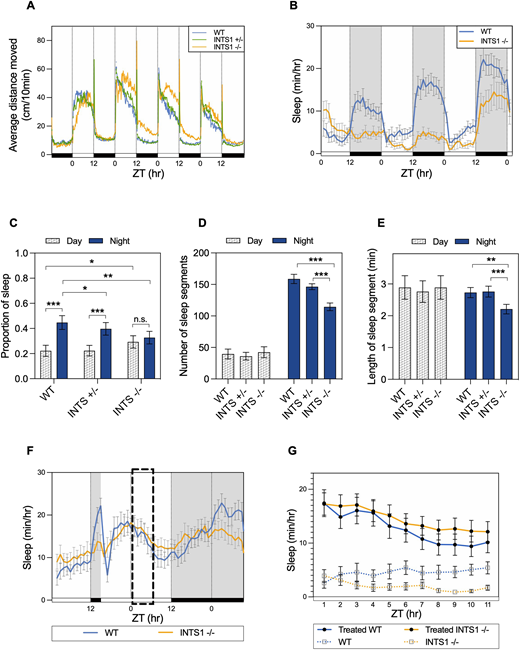Fig. 3 Ints1 function is essential for maintaining locomotor activity and sleep?wake cycles in zebrafish. (A) Locomotor activity analysis of ints1 mutant larvae and their siblings under light/dark (LD) cycles. The average distance moved (cm/10 min) is plotted on the y-axis; the zeitgeber time (ZT, in hours; 0=lights on; 12=lights off) is plotted on the x-axis. White and black horizontal bars indicate light and dark conditions, respectively. n=83 homozygotes (INTS1 ?/?); 169 heterozygotes (INTS1 +/?); 72 WT siblings. Progenies of heterozygous intercrosses were exposed to LD cycles and their locomotor activity was measured at 5?8 dpf. (B) Average sleep time of Ints1-deficient (INTS1 ?/?) larvae and their WT siblings at 6?8 dpf under LD cycles. The average sleep time [min/h] is plotted on the y-axis; ZT (h) is plotted on the x-axis. White and black horizontal bars indicate light and dark conditions, respectively. Error bars represent ąs.e. (n=24 homozygotes; 24 WT siblings). (C) Sleep proportion separately computed under light and dark conditions using data from 6?8 dpf larvae. Both WT (n=72) and heterozygous (n=169) larvae exhibited a substantial difference in sleep proportion between day and night (***P<0.001, mixed model ANOVA using Type II Wald Chi-squared tests), while no significant difference was observed between day and night for homozygotes (n=83; error bars represent ąs.e.). Homozygous mutants exhibited significantly reduced nighttime sleep compared with WT and heterozygotes (**P<0.01 and *P<0.05, respectively, mixed model ANOVA using Type II Wald Chi-squared tests), and increased daytime sleep compared with WT (*P<0.05, mixed model ANOVA using Type II Wald Chi-squared tests). n.s., non-significant. (D) Number of sleep segments per night is reduced in Ints1-deficient larvae (n=83; ***P<0.001, mixed model ANOVA followed by post-hoc analysis) compared with WT (n=72) and heterozygous (n=169) larvae. Error bars represent ąs.e. (E) Reduced length of sleep segment during the night was observed for ints1-deficient larvae (n=83) compared with WT (n=72) and heterozygous (n=169) larvae (**P<0.01 and ***P<0.001, mixed model ANOVA followed by post-hoc analysis). Error bars represent ąs.e. (F) LD-trained larvae were exposed to 9 h of sleep deprivation, starting from 3 h after lights out. The average sleep time (min/h) is plotted on the y-axis; ZT (h) is plotted on the x-axis. White and black horizontal bars indicate light and dark conditions, respectively. Error bars represent ąs.e. (n=33 homozygotes; 38 WT siblings). Normal sleep rebound (indicated by dashed box) was measured in homozygotes with respect to their WT siblings. (G) Sleep rebound was measured in sleep-deprived WT and Ints1-deficient larvae compared with non-deprived larvae during the day after sleep-deprivation treatment. The average sleep time (min/h) is plotted on the y-axis; ZT (h) is plotted on the x-axis. Error bars represent ąs.e. (n=34 homozygotes; 32 WT siblings). Both genotypes exhibited a typical consolidated sleep pattern after the sleep-deprivation treatment.
Image
Figure Caption
Figure Data
Acknowledgments
This image is the copyrighted work of the attributed author or publisher, and
ZFIN has permission only to display this image to its users.
Additional permissions should be obtained from the applicable author or publisher of the image.
Full text @ Dis. Model. Mech.

